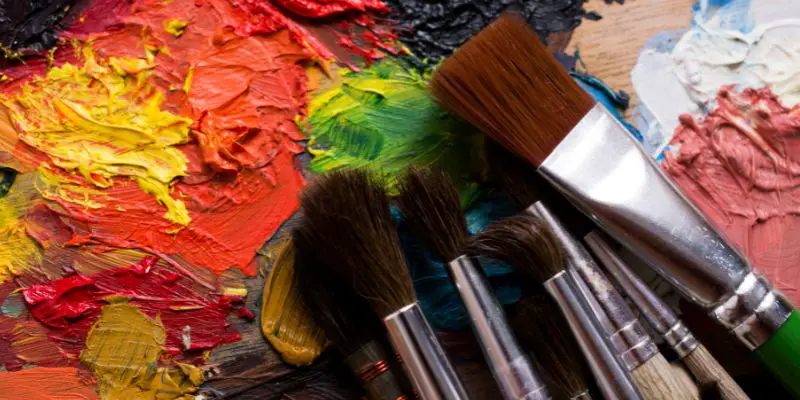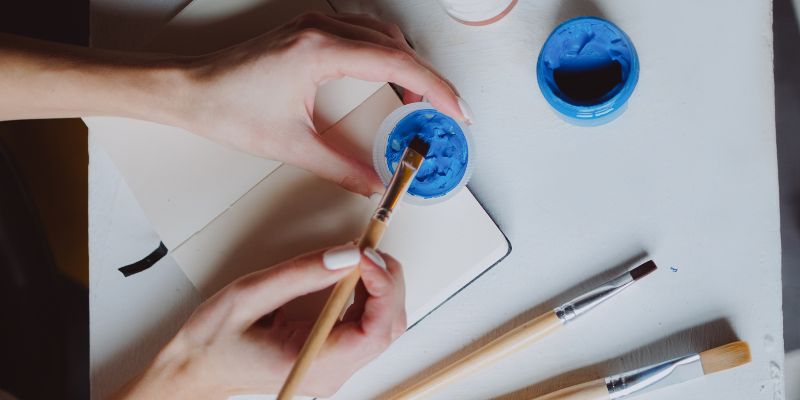Yes, acrylic paint can adhere to plastic surfaces. Acrylic paint has the ability to bond well with plastic materials, providing a durable and semi-flexible finish.
When applying acrylic paint to plastic, it is important to properly prepare the surface by cleaning it thoroughly and applying a primer specifically designed for plastic. By following these steps, you can achieve excellent adhesion and ensure that the paint sticks to the plastic surface for a long-lasting result.
So, you can confidently use acrylic paint on plastic for various art and craft projects, home décor, or any other creative endeavor.
Can Acrylic Paint Stick To Plastic?
When it comes to painting on plastic surfaces, one question that often arises is whether acrylic paint can stick to plastic. The short answer is yes, acrylic paint can adhere to plastic. However, there are some important factors to consider to achieve optimal adhesion and ensure a long-lasting finish. Let’s explore the properties of acrylic paint and its adhesion to different surfaces.
Properties Of Acrylic Paint
Acrylic paint is widely popular for its versatility and ability to provide vibrant and long-lasting colors. Its unique formulation consists of pigment particles suspended in an acrylic polymer emulsion, which acts as a binding agent and dries into a solid film. Here are some key properties of acrylic paint:
- Quick-drying: Acrylic paint dries relatively fast, allowing for multiple layers or additional mediums to be applied without significant waiting time.
- Water-soluble: While wet, acrylic paint can be thinned and cleaned up with water. However, once dried, it forms a durable, water-resistant surface.
- Flexible: Acrylic paint exhibits flexibility, making it suitable for various surfaces that may experience slight movements or expansion/contraction.
- Lightfastness: Acrylic paints are known for their excellent lightfastness, meaning the colors resist fading or changing over time when exposed to light.
Adhesion To Different Surfaces
Acrylic paint demonstrates good adhesion to a wide range of surfaces, including plastic. However, it is essential to properly prepare the plastic surface before painting to ensure optimal adhesion and long-lasting results. Here are some recommended steps to follow:
- Clean the surface: Thoroughly clean the plastic surface to remove any dirt, dust, or oily residue that may interfere with the paint’s adhesion. Use a mild detergent solution or rubbing alcohol for effective cleaning.
- Surface texture: Depending on the type of plastic, creating a roughened surface texture can help enhance adhesion. Lightly sanding the plastic with fine-grit sandpaper or using a plastic primer can promote better paint adhesion.
- Priming: Applying a suitable primer designed for plastic surfaces can further improve adhesion and provide a stable base for the acrylic paint. Choose a primer recommended for both the type of plastic and acrylic paint you intend to use.
- Paint application: When applying acrylic paint to plastic, it’s best to use thin, even coats. Multiple layers may be needed to achieve the desired opacity and color intensity.
- Sealing: Finally, consider sealing the painted plastic surface with a clear acrylic varnish or sealer. This protective layer can help preserve the paint and provide additional durability.
In conclusion, acrylic paint can stick to plastic surfaces when proper preparation and application techniques are followed. Understanding the properties of acrylic paint and taking the necessary steps to promote adhesion will ensure that your painted plastic objects retain their vibrant colors and withstand the test of time.

Preparation Techniques
The key to a successful acrylic paint project on plastic lies in proper preparation techniques. By taking the time to clean the plastic surface, apply a primer, and select the right brushes and tools, you can ensure that the acrylic paint will adhere effectively. In this blog post, we will walk you through each of these steps in detail, providing you with the knowledge and guidance to create stunning and long-lasting art on plastic surfaces.
Cleaning The Plastic Surface
Before starting any painting project on plastic, it is essential to clean the surface thoroughly. Unclean plastic surfaces can have dust, dirt, grease, or other contaminants that can prevent proper paint adhesion. To clean the plastic surface:
- Wipe down the plastic surface with a damp cloth or sponge to remove any loose debris or dust particles.
- Mix a mild detergent or soap with water and apply the solution to the plastic surface.
- Gently scrub the surface using a soft-bristle brush or sponge.
- Rinse off the soap residue with clean water.
- Dry the surface thoroughly with a clean cloth or allow it to air dry.
Properly cleaning the plastic surface will ensure that no dirt or grease interferes with the paint’s ability to adhere. By following these cleaning techniques, you can create a smooth and clean surface that is ready for painting.
Applying A Primer
To improve the acrylic paint’s adhesion to plastic, it is recommended to apply a primer before painting. A primer creates a bond between the plastic surface and the paint, allowing the paint to stick better and last longer. Here are the steps to apply a primer:
- Choose a primer specifically designed for plastic surfaces. Look for a product that is labeled as “plastic primer” or “adhesion promoter.”
- Ensure the plastic surface is clean and dry, following the cleaning techniques mentioned earlier.
- Shake the primer can well and apply it in thin, even coats. Hold the can approximately 6-8 inches away from the surface.
- Allow each coat to dry completely before applying additional coats. Consult the product’s instructions for the recommended drying time.
- Once the primer is dry, lightly sand the surface with fine-grit sandpaper to create a smoother painting surface, if desired.
Applying a primer provides a strong foundation for the acrylic paint to adhere to the plastic surface. Follow these steps and create a smooth and durable surface for your artwork.
Choosing The Right Brushes And Tools
Using the right brushes and tools is crucial for achieving the desired results when painting with acrylic paint on plastic. Here are some tips to help you make the right choices:
- Choose brushes made from synthetic materials, such as nylon or polyester. These brushes work well with acrylic paints and can provide smooth brushstrokes.
- Consider using brushes with firmer bristles for better control and precise details.
- If using a paintbrush for fine details, opt for a small, thin brush.
- Have a variety of brush sizes available to accommodate different areas and intricacies of your artwork.
- Additionally, use other tools like palette knives or sponges to create different textures on the plastic surface.
By selecting the appropriate brushes and tools, you can enhance your painting techniques and achieve the desired effects on plastic surfaces. Experiment with different brush sizes and techniques to add depth and interest to your artwork.
Techniques For Applying Acrylic Paint On Plastic
When it comes to painting on plastic surfaces, using acrylic paint can be a great option. Acrylic paint is known for its versatility and durability, making it suitable for a wide range of materials, including plastic. However, in order to achieve the best adhesion and long-lasting results, it is important to use the right techniques when applying acrylic paint on plastic.
Brushing On The Paint
Brushing on acrylic paint is one of the most common techniques for applying paint on plastic surfaces. Here are a few tips to help you get the best results:
- Use a synthetic bristle brush for better control and smoother application.
- Start by thoroughly cleaning the plastic surface to remove any dirt or grease that may interfere with the paint’s adhesion.
- Apply a primer specifically designed for plastic surfaces to create a smooth and even base for the paint.
- Begin painting with thin layers, allowing each layer to dry completely before applying the next coat. This helps to prevent cracking or peeling of the paint.
- For optimal results, apply two to three coats of paint, ensuring each layer is evenly applied.
- Seal the painted plastic surface with a clear acrylic sealer to protect the paint from scratches and fading.
Spraying The Paint
Spraying acrylic paint is another technique that can yield excellent results on plastic surfaces. Here’s what you need to know:
- Use an airbrush or a spray gun specifically designed for acrylic paint application.
- Thin the acrylic paint with water or a compatible acrylic medium to achieve the desired consistency for spraying.
- Start by applying a light mist coat to create a base layer. Allow it to dry completely before applying additional coats.
- Build up the paint layers gradually, focusing on even coverage and avoiding drips or runs.
- Be patient and allow sufficient drying time between coats to avoid smudging or smearing the paint.
- Finish with a clear acrylic sealer to protect the paint and add a glossy or matte finish, depending on your preference.
Sponging Or Dabbing The Paint
Sponging or dabbing the paint provides a unique texture and visual effect. Here’s how to achieve it:
- Start by pouring small amounts of acrylic paint onto a palette or plate.
- Dip a sponge or sponge brush into the paint and lightly dab or sponge it onto the plastic surface.
- Experiment with different sponge sizes and textures to create various patterns and effects.
- Allow the paint to dry completely and assess if additional coats are needed to achieve the desired coverage.
- Once satisfied with the overall finish, seal the painted plastic surface with a clear acrylic sealer for added protection.
Painting In Thin Layers
When painting on plastic, using thin layers of paint is crucial for proper adhesion and a professional-looking finish. Consider the following:
- Begin by cleaning the plastic surface thoroughly to ensure proper paint adhesion.
- Apply a primer suitable for plastic surfaces, ensuring an even and smooth base.
- Start with a thin layer of acrylic paint, using a brush, spray, or sponge technique.
- Allow the first layer to dry completely before applying additional coats, ensuring each layer is thin and evenly applied.
- Building up the paint gradually reduces the risk of the paint cracking or peeling over time.
- Finish with a clear acrylic sealer to protect the painted plastic surface from wear and tear.

Tips And Tricks For Better Adhesion
When it comes to painting plastic surfaces with acrylic paint, achieving good adhesion can be sometimes challenging. However, with a few tips and tricks, you can greatly improve the adhesion of acrylic paint to plastic. In this section, we will discuss some effective techniques that you can employ to ensure better adherence and enhance the longevity of your artwork.
Adding Mediums To The Paint
One effective way to improve the adhesion of acrylic paint to plastic is by adding mediums to the paint itself. Acrylic mediums are specifically designed to enhance the flow and adhesion of acrylic paints.
- Mediums can also contain additives that increase the bonding properties between the paint and the plastic surface.
- Consider using a medium with strong adhesive properties, such as an acrylic gel medium, to ensure optimal adhesion.
- When mixing the medium with the paint, follow the manufacturer’s instructions for the recommended ratio of paint to medium.
Using Heat To Improve Adhesion
Another technique that can help improve the adhesion of acrylic paint to plastic is the use of heat. Applying heat to the painted surface can help the paint bond more securely with the plastic.
- Use a heat gun or a hairdryer on a low setting to gently warm up the painted area.
- Be cautious not to overheat the plastic, as it can cause deformation or damage to the surface.
- Allow the paint and plastic to cool down naturally after applying heat, as sudden temperature changes can affect the adhesion.
Sealing The Painted Surface
To ensure the longevity and durability of your painted plastic surface, it is recommended to seal the paint with a protective coat. Sealing the paint not only enhances its adhesion but also provides protection against external factors such as moisture and UV rays.
Here are a few options to consider when sealing your painted plastic surface:
- Acrylic varnish: Apply one or two coats of acrylic varnish over the dried paint, following the manufacturer’s instructions. This will provide a protective layer and enhance the adhesion.
- Epoxy resin: For a more durable and glossy finish, you can opt for epoxy resin. Mix the resin according to the instructions and carefully apply it over the painted surface. Allow it to cure completely.
- Clear spray sealer: If you prefer a quick and easy option, you can use a clear spray sealer specifically designed for use on acrylic paint. Apply a light and even coat over the painted surface, following the recommended drying time.
Conclusion
Acrylic paint can definitely stick to plastic surfaces, but proper surface preparation is crucial. By cleaning and priming the plastic beforehand, you can ensure a better bond and longevity of your artwork. Experimenting with different techniques, such as sanding, may also help the paint adhere better.
Overall, with the right preparation and technique, you can create beautiful and long-lasting artwork on plastic using acrylic paint.


